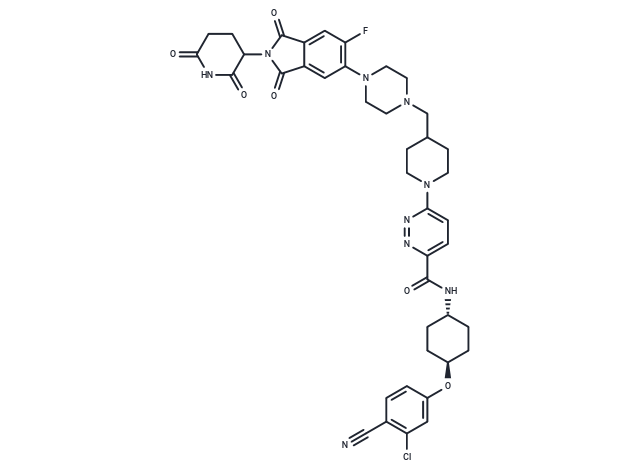Shopping Cart
- Remove All
 Your shopping cart is currently empty
Your shopping cart is currently empty

Bavdegalutamide (ARV-110) is an oral protein degrader that specifically binds to AR and mediates its degradation. Bavdegalutamide can degrade clinically relevant mutant AR proteins, maintain activity in a high androgen environment, and has an acceptable safety profile.

| Pack Size | Price | Availability | Quantity |
|---|---|---|---|
| 2 mg | $85 | In Stock | |
| 5 mg | $139 | In Stock | |
| 10 mg | $216 | In Stock | |
| 25 mg | $424 | In Stock | |
| 50 mg | $545 | In Stock | |
| 100 mg | $785 | In Stock | |
| 200 mg | $1,090 | In Stock |
| Description | Bavdegalutamide (ARV-110) is an oral protein degrader that specifically binds to AR and mediates its degradation. Bavdegalutamide can degrade clinically relevant mutant AR proteins, maintain activity in a high androgen environment, and has an acceptable safety profile. |
| In vitro | Bavdegalutamide (ARV-110) completely degrades AR in all cell lines tested, with an observed 50% degradation concentration (DC50) of < 1 nM. [3] |
| In vivo | METHODS: The mean plasma concentration-time profiles of Bavdegalutamide (ARV-110) were measured in rats and mice after intravenous administration of Bavdegalutamide (2 mg/kg, intravenous injection) and (5 mg/kg, oral administration) using the developed LC-MS/MS method. RESULTS: In rats, after intravenous injection of Bavdegalutamide, the calculated total clearance (CL) value was 413.6 ± 31.7 mL/h/kg, and the steady-state (VSS) value (5775 ± 320 mL/kg) indicated that ARV-110 was well distributed in tissues; after oral administration, the peak plasma concentration (Cmax) value was 110.5 ± 9.2 ng/mL, at 5.5 ± 1.9 hours, and the oral bioavailability of ARV-110 in rats was moderate (23.8%); after intravenous administration in mice, the CL value of ARV-110 was lower than the hepatic blood flow rate of mice (90 mL/min/kg), and Bavdegalutamide showed a relatively large VSS value (2366 ± 402.2 mL/kg), indicating that the drug was mainly confined to tissues; after oral administration, the Cmax value was 612.0 ± 88.38 ng/mL. [2] METHODS: Bavdegalutamide (1 mg/kg, orally, once a day) was used to treat xenograft model mice, and the degree of AR degradation and tumor growth in the mice were observed. RESULTS: With over 90% AR degradation in mice, Bavdegalutamide achieved significant inhibition of tumor growth and AR signaling in both intact and castrated conditions. [3] |
| Alias | ARV-110 |
| Molecular Weight | 812.29 |
| Formula | C41H43ClFN9O6 |
| Cas No. | 2222112-77-6 |
| Smiles | O=C1C=2C(C(=O)N1C3C(=O)NC(=O)CC3)=CC(F)=C(C2)N4CCN(CC5CCN(CC5)C6=CC=C(C(N[C@@H]7CC[C@@H](OC8=CC(Cl)=C(C#N)C=C8)CC7)=O)N=N6)CC4 |
| Relative Density. | 1.49 g/cm3 (Predicted) |
| Storage | Powder: -20°C for 3 years | In solvent: -80°C for 1 year | Shipping with blue ice. | ||||||||||||||||||||||||||||||
| Solubility Information | DMSO: 46 mg/mL (56.63 mM), Sonication is recommended. | ||||||||||||||||||||||||||||||
Solution Preparation Table | |||||||||||||||||||||||||||||||
DMSO
| |||||||||||||||||||||||||||||||

Copyright © 2015-2025 TargetMol Chemicals Inc. All Rights Reserved.